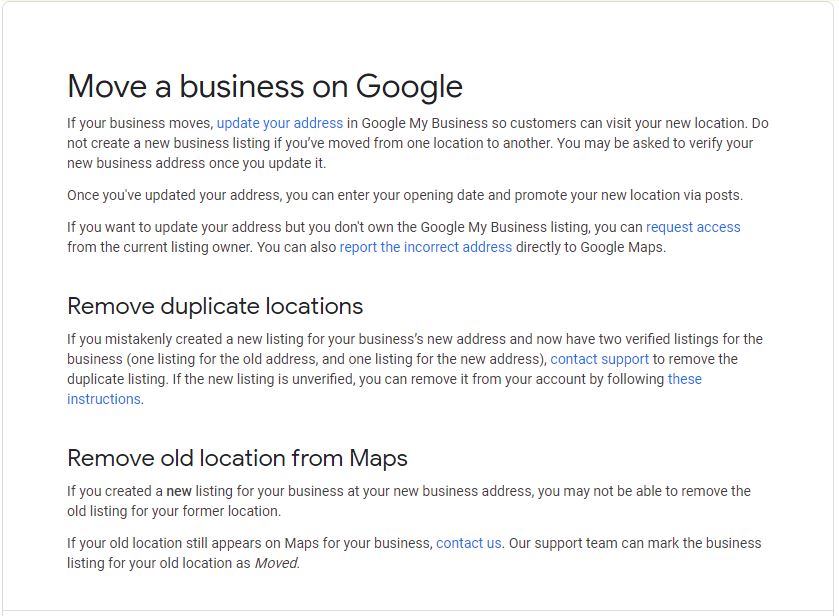In most scenarios, preparing your business for a move to a new location is a sign of success.
Maybe you’ve outgrown your old location, maybe you’re moving to a swankier place, or maybe you’re heading downtown to be closer to your clients.
Whatever the case, moving is an exciting time for local businesses much in the same way it is for individuals—it’s a new opportunity and the beginning of a new era.
Unfortunately, moving your business has a few downsides.
Even if you spend the days and weeks leading up to the move updating your clients and partners about the change, there’s still one major hiccup that can damage your business as a result of switching business addresses: your local SEO could suffer.
If you’re proactive and dutiful, you can avoid the worst and make the transition to your new business locations without any major interruptions in the progress of your local SEO campaign.
This article will show you how to get it done.

Table of Contents
The Problem With Moving
Usually, when we talk about seeing a ranking drop or a decrease in domain authority, it’s because Google is mad at you. Posting spammy links or bad content is a violation of Google’s official policies, and doing so will make them penalize you. Moving to a new location isn’t going to make Google mad—but at the same time, if you handle it improperly, it can cause your rankings to plummet.
Here’s the root of the problem: your NAP. “NAP” is shorthand for name, address, and phone number—the three critical pieces of information Google uses to categorize and understand your business.
Because this information is vital to producing accurate, reliable local search results, Google takes it very seriously.
But rather than relying on local businesses to present this information on their own, Google tries to fact-check by aggregating information from all over the web. It might take the NAP information on your site and compare it against your NAP as it exists on Yelp, TripAdvisor, and a thousand other third-party local directories.
If it finds that your NAP is inconsistent, it serves as a blow against you, and two things might happen—your domain authority might drop, and your address might populate incorrectly for any relevant inbound queries. Neither is good for your search visibility.
Unfortunately, there’s no quick fix to this. Google’s aggregation of data makes its search results far more accurate, but it also means it takes a longer time for your information to update throughout the web. If you update your NAP information on your own site, it might take months or even years for those independent local directories to catch on and update their databases, and even more time for Google’s data refreshes to catch up to the change. In the meantime, you’ll be losing tons of potential visibility and traffic.
How to Prepare for the Change
Unfortunately, there isn’t much you can do in advance of your move. You can’t write a letter to Google explaining the address transition or schedule your address change the way you can with the United States Postal Service.
Plus, changing your business address too early can be just as problematic as changing your address too late.
Instead, all you can do is proactively prepare for the transition period and be ready to take action the minute your address officially changes.
Making the Switch
When you finally make the move to your new physical location, you’ll have to take several steps to ensure your new local business listings data is incorporated throughout the web as thoroughly, as accurately, and of course, as quickly as possible.
Your Website
First and foremost, update your website—and update it everywhere. It’s the first place Google checks when evaluating your NAP information.
Include your full information in the footer, with a phone number in the header, and be sure all your internal pages—especially a business page—are updated as well.
If you have any location-specific internal pages, make a note to update them with the new location.
Social Media Profiles
Next, you’ll want to update your social media profiles. These are easy to miss, especially if you don’t regularly audit your content and social profile information as part of an on-going SEO audit process.
Make it a point to not only update your basic profile information on every platform you use, but also to post an announcement to your audience addressing the change.
Local Directories and Databases
This is the tough part. There are literally thousands of different local directories and databases that have your information on file, and they’re all perused by Google’s search crawlers as a potential source of valuable information.
If you want to be thorough, you’ll need to update as many of them as possible.
There are services out there that will clean up your local profile for free—for a few hundred dollars, they’ll track down every instance of your business’s information on the web, and they’ll manually update it to reflect your current location.
For the time-strapped business with a bit of extra money to spare, this service is definitely worth it.
Otherwise, you can manually track down these instances and update them one by one. Generally, you can find them by searching for your own business name. Then, you can claim your Google my Business profile and update your information in the back end of the system, or write to the webmaster to inform them of the change. If you’re doing this, it will be impossible to update every single instance of your business on the web—for now, stick to the major players like Yelp, Trip Advisor, and UrbanSpoon.
No matter what approach you use in updating your address throughout the web or how quickly you act after the initial move takes place, remember that the transition is going to take some time.
You could spend a few weeks or even a few months with your address in a transition state, but as long as you act quickly and thoroughly, you should have no trouble minimizing the SEO fallout and keeping your domain authority afloat.
Ready to get started improving your local SEO efforts?
Take a look at these 14 local SEO strategies and tips for busy marketers!
Tim holds expertise in building and scaling sales operations, helping companies increase revenue efficiency and drive growth from websites and sales teams.
When he's not working, Tim enjoys playing a few rounds of disc golf, running, and spending time with his wife and family on the beach...preferably in Hawaii.
Over the years he's written for publications like Forbes, Entrepreneur, Marketing Land, Search Engine Journal, ReadWrite and other highly respected online publications. Connect with Tim on Linkedin & Twitter.
- Pros & Cons of Using Indian Link Building Services - April 14, 2025
- Search Everywhere Optimization: The New and Improved SEO - April 14, 2025
- Best Link Building Strategies for SEO in 2025 - April 1, 2025



